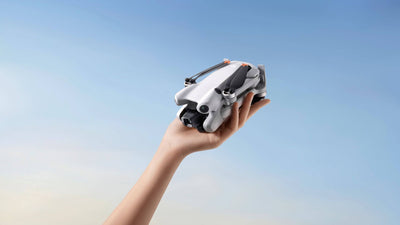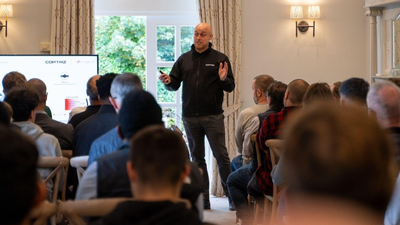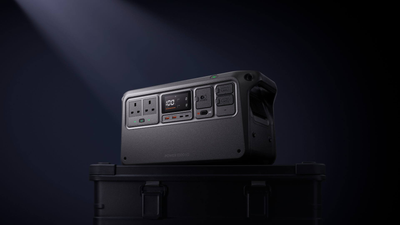DJI Power 1000 V2 vs Power 1000: What’s The Real Difference?
- by Stefan Gandhi
Portable power stations are fast becoming essentials for drone pilots, remote creators and anyone who needs reliable off-grid electricity. DJI, best known for its market-leading drones, has also made a mark in the portable power space. With the release of the DJI Power 1000 V2, users are left wondering: how does it compare to the original Power 1000?
Both models promise high capacity and professional-grade utility, but the V2 brings forward enhancements that matter in real-world scenarios. If you're looking for a robust, high-performance power station that supports your gear in the field or at home, this breakdown will help you decide which model suits your workflow best.
Power Capacity and Output Performance
On paper, both the Power 1000 and Power 1000 V2 offer a 1024 Wh capacity, ensuring plenty of energy for charging drones, laptops, cameras and essential devices. However, the Power 1000 V2 edges ahead with a significant boost in maximum continuous output: 2600 W compared to the original's 2200 W.
This 400 W increase allows the V2 to handle more demanding equipment or multiple high-draw devices at once. For drone professionals using powerful chargers or content creators running several accessories simultaneously, this is a meaningful upgrade that supports seamless productivity in the field.
Charging Speed and Usability
Speed of recharge is a dealbreaker for mobile users. The Power 1000 V2 has been engineered to cut downtime dramatically. It charges from 0 to 80% in just 37 minutes, and to 100% in only 56 minutes using fast charging mode. That means even if you're packing in a rush, a short charge window still gives you real usability.
The original Power 1000 isn't slow, but its 50-minute time to reach 80% and 80-minute solar recharge benchmark puts it just behind the V2's lightning-fast turnaround.
For professionals on location, timing is everything. The Power 1000 V2 gives you a dependable edge with its faster prep time.
Noise Levels and Comfort
Another underrated spec in power stations is operational noise, especially for those filming audio-sensitive content or trying to rest in quiet spaces like tents or caravans.
The Power 1000 runs at an ultra-quiet 23 dB during recharging, which is already impressive. The Power 1000 V2, despite slightly higher output, operates at just 26 dB during charging – quieter than a whisper and no louder than a silent air conditioner.
This makes the V2 a solid choice for both indoor and outdoor use where background noise matters. The difference is subtle, but in a real-world environment, it offers greater acoustic comfort without sacrificing power.
Port Configuration and Design
Both versions offer the same comprehensive port layout:
- AC Output × 2
- USB-C × 2
- USB-A × 2
- SDC × 1
- SDC Lite × 1
- AC Input × 1
This configuration ensures compatibility with everything from drone batteries and laptops to phones and portable fridges.
Physically, both models share identical dimensions (448×225×230 mm), but the V2 adds slightly more weight at 14.2 kg versus the original's 13 kg. This small difference is justified by its enhanced internals and reinforced capabilities.
Battery Longevity and Reliability
Both the Power 1000 and Power 1000 V2 use LFP (lithium ferrophosphate) cell chemistry, prized for safety, durability and stability.
Where the V2 really stands out is in cycle life. It retains over 80% of its capacity after 4000 full charge-discharge cycles, compared to 70% for the original Power 1000 under identical test conditions.
This means longer-term reliability and better performance for users who charge frequently. If you're on the road regularly or rely on battery storage as part of your job, the V2 offers greater value and lifespan over time.
Altitude and Environment Readiness
For drone pilots flying in varied terrains or remote areas, environmental tolerance matters. The Power 1000 is rated to operate up to 3000 metres altitude, while the Power 1000 V2 raises that bar to 5000 metres.
That added elevation threshold opens doors for more adventurous use. Whether you're filming in the Scottish Highlands or setting up a workstation in a mountainous region, the V2 is built for high-altitude performance without compromise.
Real-World Use Case Comparison
Let’s imagine a drone team working in rugged outdoor locations:
- With the Power 1000, they can comfortably run chargers and devices, provided their setup stays below the 2200 W continuous output. Charging downtime is manageable, and the quiet operation suits tranquil filming conditions.
- With the Power 1000 V2, they gain the freedom to plug in more demanding equipment, recharge much faster between locations, and work in higher altitudes without stress. Over time, the better battery retention also reduces replacement costs and ensures consistency.
For casual users or those with lighter workloads, the original Power 1000 still delivers strong performance. But for serious creators, professionals, or frequent field users, the Power 1000 V2 steps up where it counts.
Conclusion
On the surface, the DJI Power 1000 and Power 1000 V2 may seem nearly identical. But under closer inspection, the V2 introduces critical refinements: higher continuous output, significantly faster charging, superior battery longevity, and higher altitude operation.
While the original Power 1000 remains a solid and dependable unit, the Power 1000 V2 is clearly the better investment for those who need peak performance, long-term reliability, and minimal downtime.
Whether you're powering up a drone fleet, filming in extreme conditions, or just want a future-proof portable energy source, the Power 1000 V2 is the smarter choice.
Ready to level up your power game? Visit the Coptrz online store today to get your DJI Power 1000 V2 and elevate your drone operations with unmatched portable power.




